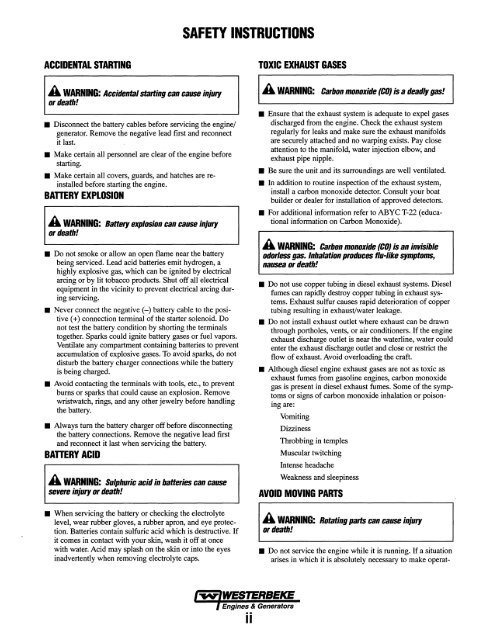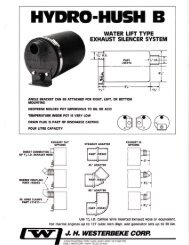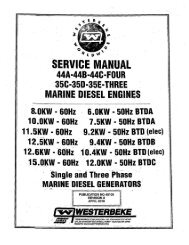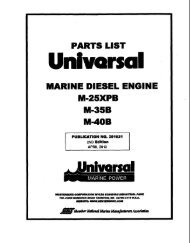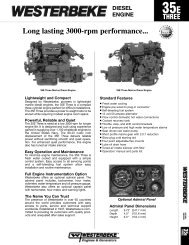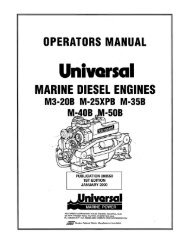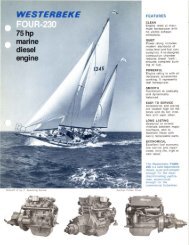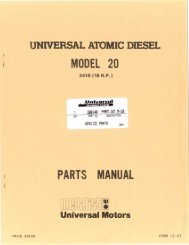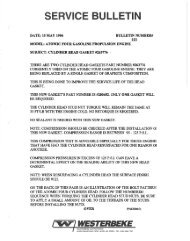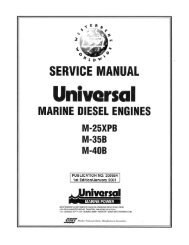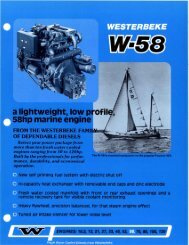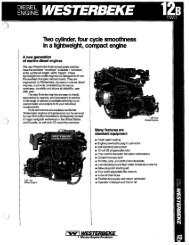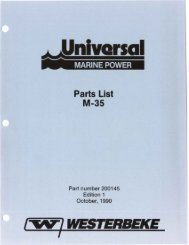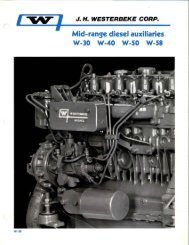service manual 55a four marine diesel engine - Westerbeke
service manual 55a four marine diesel engine - Westerbeke
service manual 55a four marine diesel engine - Westerbeke
Create successful ePaper yourself
Turn your PDF publications into a flip-book with our unique Google optimized e-Paper software.
SAFETY INSTRUCTIONS<br />
ACCIDENTAL STARTING<br />
TOXIC EXHAUST GASES<br />
A WARNING: Accidental starting can cause injury<br />
Dr death!<br />
• Disconnect the battery cables before servicing the <strong>engine</strong>/<br />
generator. Remove the negative lead first and reconnect<br />
it last.<br />
• Make certain all personnel are clear of the <strong>engine</strong> before<br />
starting.<br />
• Make certain all covers, guards, and hatches are reinstalled<br />
before starting the <strong>engine</strong>.<br />
BAnERY EXPLOSION<br />
A WARNING: Battery explDsiDn can cause injury<br />
Dr death!<br />
• Do not smoke or allow an open flame near the battery<br />
being <strong>service</strong>d. Lead acid batteries emit hydrogen, a<br />
highly explosive gas, which can be ignited by electrical<br />
arcing or by lit tobacco products. Shut off all electrical<br />
equipment in the vicinity to prevent electrical arcing during<br />
servicing.<br />
• Never connect the negative (-) battery cable to the positive<br />
(+) connection terminal of the starter solenoid. Do<br />
not test the battery condition by shorting the terminals<br />
together. Sparks could ignite battery gases or fuel vapors.<br />
Ventilate any compartment containing batteries to prevent<br />
accumulation of explosive gases. To avoid sparks, do not<br />
disturb the battery charger connections while the battery<br />
is being charged.<br />
• Avoid contacting the terminals with tools, etc., to prevent<br />
burns or sparks that could cause an explosion. Remove<br />
wristwatch, rings, and any other jewelry before handling<br />
the battery.<br />
• Always turn the battery charger off before disconnecting<br />
the battery connections. Remove the negative lead first<br />
and reconnect it last when servicing the battery.<br />
BAnERYACID<br />
A WARNING: Sulphuric acid in batteries can cause<br />
severe injury Dr death!<br />
• When servicing the battery or checking the electrolyte<br />
level, wear rubber gloves, a rubber apron, and eye protection.<br />
Batteries contain sulfuric acid which is destructive. If<br />
it comes in contact with your skin, wash it off at once<br />
with water. Acid may splash on the skin or into the eyes<br />
inadvertently when removing electrolyte caps.<br />
A WARNING: CarbDn mDnDxide (CO) is a deadly gas!<br />
• Ensure that the exhaust system is adequate to expel gases<br />
discharged from the <strong>engine</strong>. Check the exhaust system<br />
regularly for leaks and make sure the exhaust manifolds<br />
are securely attached and no warping exists. Pay close<br />
attention to the manifold, water injection elbow, and<br />
exhaust pipe nipple.<br />
• Be sure the unit and its surroundings are well ventilated.<br />
• In addition to routine inspection of the exhaust system,<br />
install a carbon monoxide detector. Consult your boat<br />
builder or dealer for installation of approved detectors.<br />
• For additional information refer to ABYC T-22 (educational<br />
information on Carbon Monoxide).<br />
A WARNING: CarbDn mDnDxide (CO) is an invisible<br />
DdDrless gas. InhalatiDn prDduces flu-like symptDms,<br />
nausea Dr death!<br />
• Do not use copper tubing in <strong>diesel</strong> exhaust systems. Diesel<br />
fumes can rapidly destroy copper tubing in exhaust systems.<br />
Exhaust sulfur causes rapid deterioration of copper<br />
tubing resulting in exhaust/water leakage.<br />
• Do not install exhaust outlet where exhaust can be drawn<br />
through portholes, vents, or air conditioners. If the <strong>engine</strong><br />
exhaust discharge outlet is near the waterline, water could<br />
enter the exhaust discharge outlet and close or restrict the<br />
flow of exhaust. Avoid overloading the craft.<br />
• Although <strong>diesel</strong> <strong>engine</strong> exhaust gases are not as toxic as<br />
exhaust fumes from gasoline <strong>engine</strong>s, carbon monoxide<br />
gas is present in <strong>diesel</strong> exhaust fumes. Some of the symptoms<br />
or signs of carbon monoxide inhalation or poisoning<br />
are:<br />
Vomiting<br />
Dizziness<br />
Throbbing in temples<br />
Muscular twitching<br />
Intense headache<br />
Weakness and sleepiness<br />
AVOID MOVING PARTS<br />
A WARNING: Rotating parts can cause injury<br />
Dr death!<br />
• Do not <strong>service</strong> the <strong>engine</strong> while it is running. If a situation<br />
arises in which it is absolutely necessary to make operat-<br />
Engines & Generators<br />
ii


